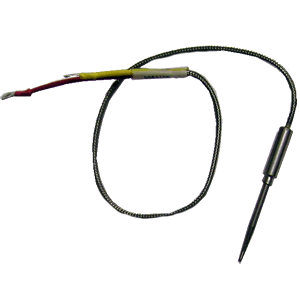 A CDT probe is used in aircraft as well as in ships. The ones used in ships are known as Conductivity, Temperature and Depth probe. It provides data on water salinity or lack thereof, it's temperature and water depth at current location.
A CDT probe is used in aircraft as well as in ships. The ones used in ships are known as Conductivity, Temperature and Depth probe. It provides data on water salinity or lack thereof, it's temperature and water depth at current location.
The CDT probe used in aircraft on the other hand, is used to measure compressor discharge temperature of the aircraft compressor and is therefore installed in the engine compartment just ahead of the inter-cooler. The CDT probe kit for the aircraft usually comes accompanied with a stainless-steel clamp to be fitted around the air-port leaving the inter-cooler.
The CDT probe kit as supplied by US-based J.P Instruments features a thermocouple type ‘K’ CDT Probe along with a stainless-steel clamp thimble and also includes one stainless steel exhaust seal washer and one stainless steel screw type clamp.
The purpose of wanting to know the discharge temperature of the aircraft compressor is to prevent the possibility of detonation brought about by excessive heat in the compressor of the aircraft.
What usually happens is that, the aircraft intercooler cools the air so much that the upper limit of temperature is usually never reached. Basically, pilots need to know the inlet temperature limits for the aircraft engine and the temperature of the air at this point. So long as the CDT indicates a temperature reading that is below what the maximum should be, the aircraft is fine. If CDT temperature reading is above the upper limit, the pilot has to take a call on whether the conditions justify the reading.
As we are aware, CDT can be critical under certain circumstances e.g. staging a dual annular combustor for a high bypass turbofan commercial jet engine where fuel-to-air ration can be critical.
Specifications and working of the CDT in aircraft: To obtain the correct compressor discharge temperature reading, the IAT Probes is mounted externally but directly in the flow path of the air discharged from the compressor. As the air flows, it touches at least one thermocouple and data is returned to the indicator (or EDM) in the cockpit.
Basically, a hole bored into the engine case and the CDT is fitted into that. The exhaust air gets channelled into this hole and into the housing containing the CDT probe which in turn measures the air temperature. The CDT probe returns n electrical signal to the connected display unit or Aircraft Engine Monitors mounted in the cockpit. Modern EDM’s can compare the current temperature with the pre-set max temperature and in the event of an anomaly, sound the appropriate audio-visual alarm.
What matters is the response speed of the CDT. Any temperature spikes should be brought to the pilot’s attention immediately – and this is where the JPI CDT scores. JPI’s grounded CDT Probes are manufactured using a space-age material, Hastaloy-X, capable of withstanding harsh sulphur atmosphere of temperature exhaust gas. Also, it’s 1/16" in diameter cable is less susceptible to temperature loss and therefore are more accurate than the fatter temperature probes manufactured by the rivals. You can select and buy CDT probes here: https://www.jpinstruments.com/product-category/probes-sensors/

